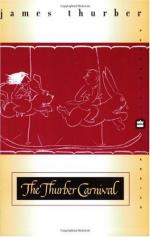|
This section contains 2,573 words (approx. 9 pages at 300 words per page) |

|
SOURCE: "The Comic Anti-Hero in American Fiction: Its First Full Articulation," in Thalia, Vol. 2, No. 3, Winter, 1979–80, pp. 11-14.
In this essay, Gehring identifies Thurber's work for the New Yorker in the 1920s as one of the first instances of a new twentieth-century literary figure, the comic antihero.
The comic anti-hero, who tries to create order in a world where order is impossible, is the dominant type in American humor today. Terms associated with anti-hero frustrations have entered our vocabulary, from Joseph Heller's "catch-22," from the book by the same name, to Kurt Vonnegut's "and so it goes," from Slaughterhouse-Five.
America's favorite cinema clown—Woody Allen—is based on the anti-hero mold, just as America's favorite cartoon character is—Charlie Brown. In today's American literature, the important comedy artists also draw equally from this mold, from Philip Roth and John Barth to the aforementioned Vonnegut and Heller. In fact...
|
This section contains 2,573 words (approx. 9 pages at 300 words per page) |

|


